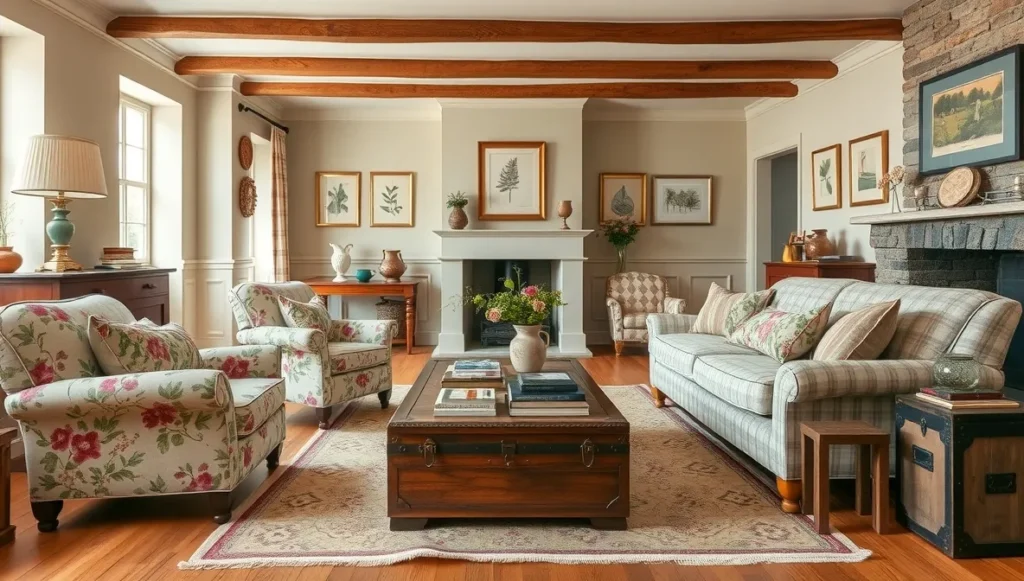- Why Vintage Interior Design Still Has My Heart - September 3, 2025
- Still in Love with Traditional Design – And Here’s Why - September 3, 2025
- The Enduring Charm of English Country Design: Why This Style Never Goes Out of Fashion - September 2, 2025
Table of Contents
I’ve been designing interiors for over two decades now, and I can’t count how many times clients have asked me about the “next big thing.” Minimalism was everywhere for a while, then industrial lofts took over, and don’t get me started on the farmhouse craze. But you know what? English Country design just keeps quietly doing its thing.
Walk into a proper English Country room and something clicks. Maybe it’s that old leather chair next to the window with roses climbing outside, or the way morning light hits those uneven plaster walls. These rooms don’t try to impress you, they just make you want to stay.
What Defines Authentic English Country Style?
Here’s what really makes English Country tick. It came from actual homes where families lived for generations. Nobody sat in a boardroom designing this look, it just happened naturally when people needed their houses to work hard and look good doing it.
Start with materials that improve with age. Oak floors that can take a beating and look better for it. Stone fireplaces that have been warming families since before your grandparents were born. Walls with character—real plaster that shows a bit of waviness because some craftsman laid it by hand decades ago. Here’s the picture of my friend’s living room in Herefordshire, England that says it all.
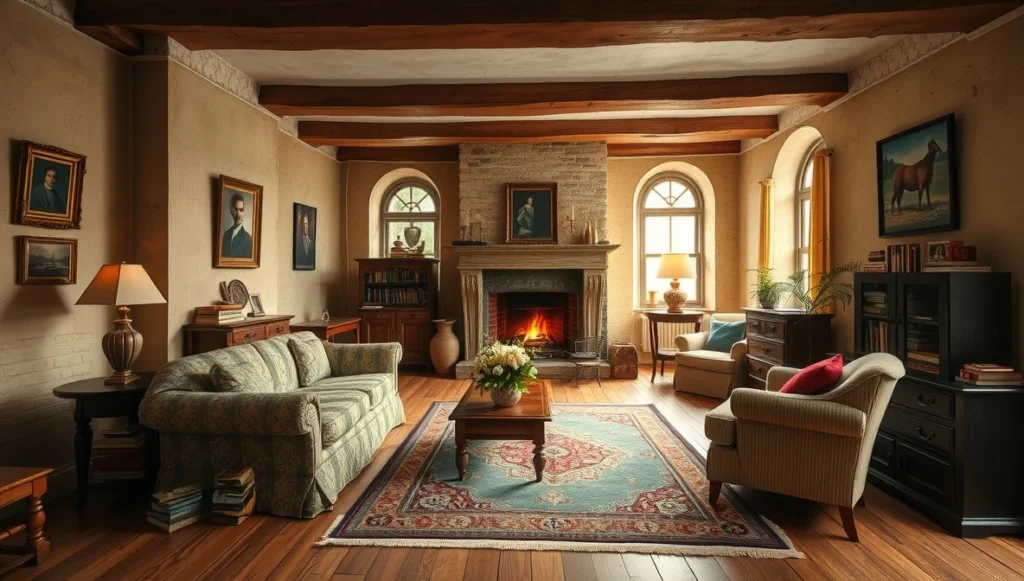
Colors work differently here than in most design styles. Think about walking through British countryside in spring — those muted greens of new grass, the soft cream of morning mist, blues like an overcast sky that somehow feels cozy rather than gloomy. Nothing jumps out and grabs you by the throat. Here’s the one I captured in Bibury – probably the most photographed English village ever!
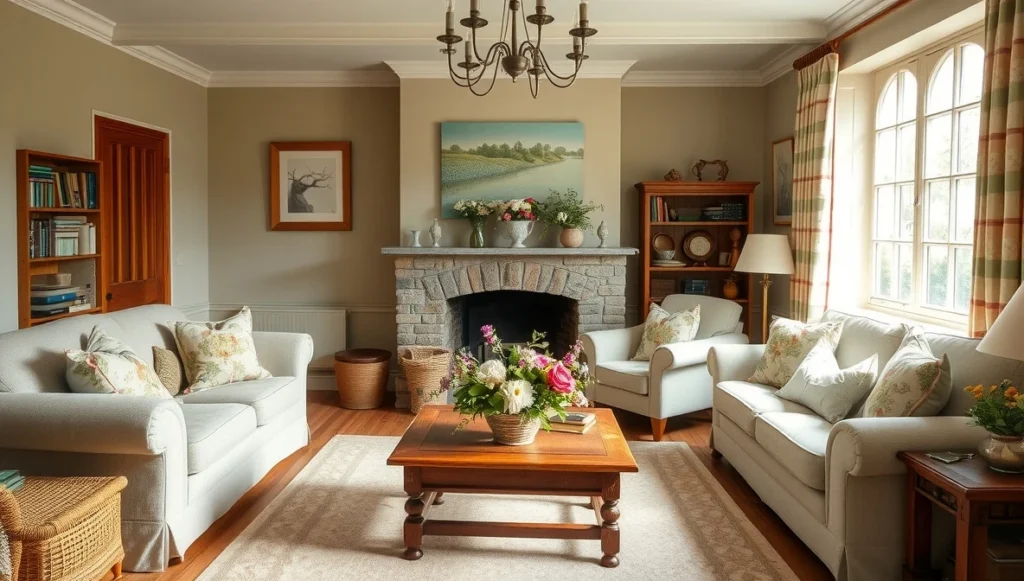
The layering part trips people up initially, but it’s actually liberating once you get it. These rooms build up slowly, like sediment. You don’t march into a store and buy a complete room, that’s not how real homes happen.
Pattern mixing scared me for years until I figured out the secret: stick to one color family and vary the scale. Big cabbage roses next to tiny sprigs, bold stripes with delicate checks. It’s like cooking, once you understand the basic proportions, you can improvise. Take a look.
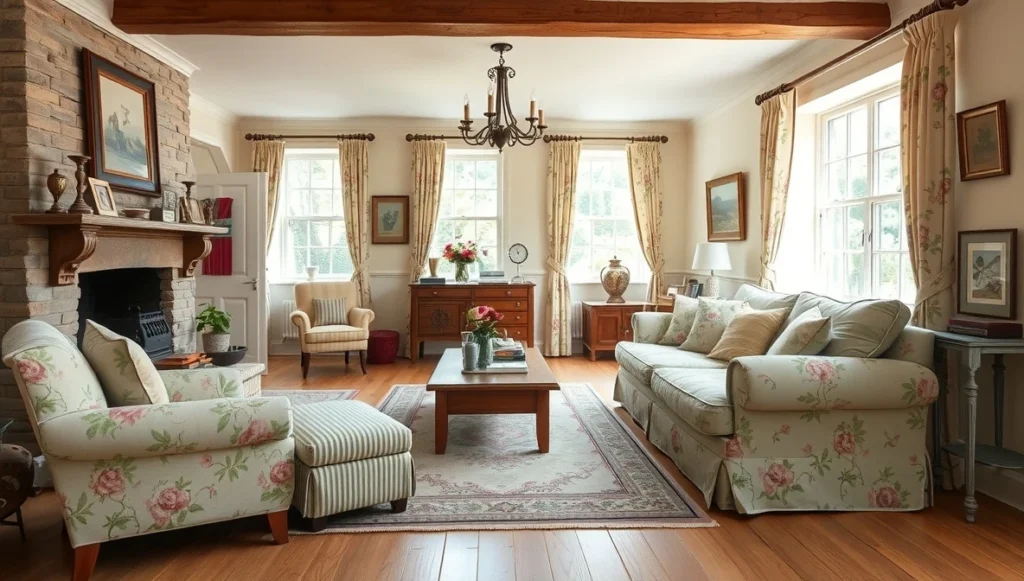
Room-by-Room Guide to English Country Style
Living Rooms: Conversation-Focused Comfort
Set up your living room for actual conversation. Revolutionary concept, right? Angle chairs and sofas toward each other instead of facing the TV like some sort of shrine.
A good Chesterfield sofa anchors everything beautifully. That deep leather that’s gotten better with age works perfectly. Pair it with some wing-backs in florals or checks. Don’t overthink the fabric mixing; as long as the colors play nicely together, you’re golden.
Skip the coffee table that matches everything else. Find an old trunk with stories, or use a big upholstered ottoman that people can actually put their feet on. Mix up your side tables. A painted piece here, natural wood there. Rooms need variety to feel alive.
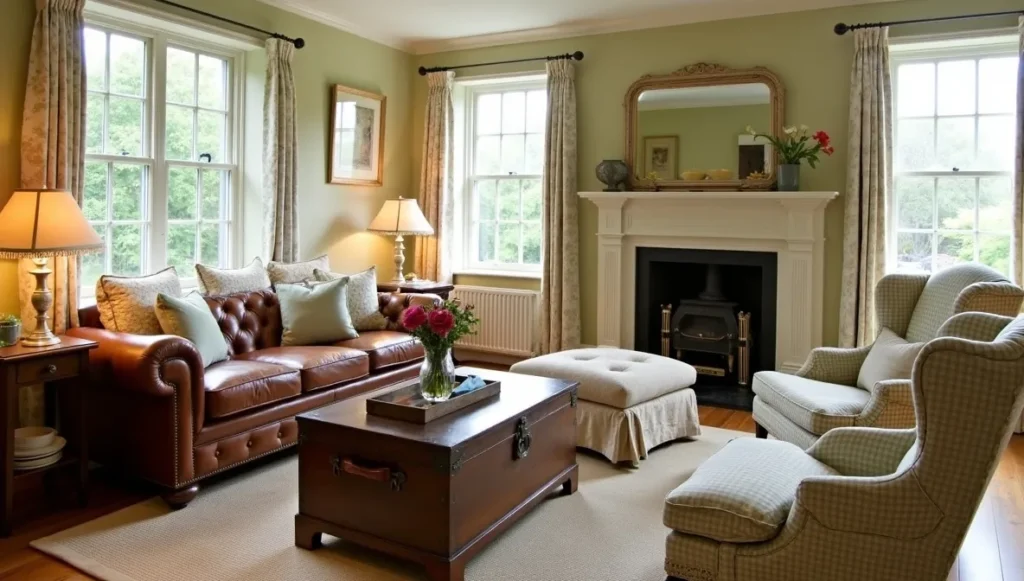
Dining Rooms: Traditional Hospitality
Dining rooms live or die by their tables. Get something substantial. Oak, mahogany, whatever, but make sure it’s got some history. Those rings from hot cups and scratches from decades of carving roasts? That’s not damage, that’s character.
Windsor chairs work perfectly, but don’t stress about perfect matching. Some of the best dining rooms I’ve done mixed different chair styles in the same wood tone. Add a Welsh dresser to show off your good china alongside everyday pieces.
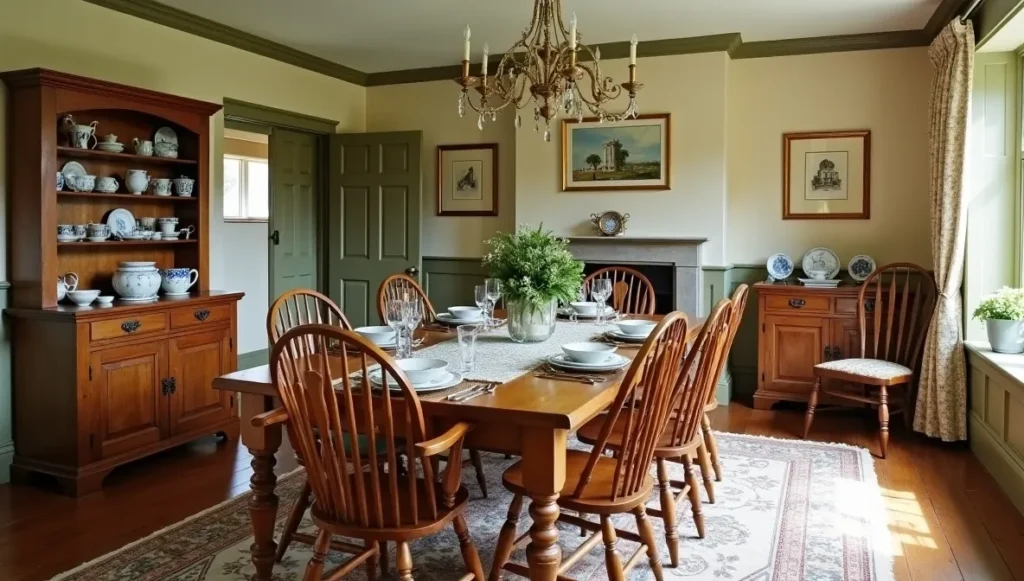
Kitchens: Beauty Meets Function
English Country kitchens break all the modern rules. Forget endless runs of matching cabinets. Think individual pieces that happen to live in the kitchen instead. A deep farmhouse sink dominates one wall. Open shelves show off the pretty dishes. Closed cabinets hide everything else.
Your work surface should be a proper table, not some space-age island. Pine, painted wood, something with actual legs that looks like furniture because it is furniture.
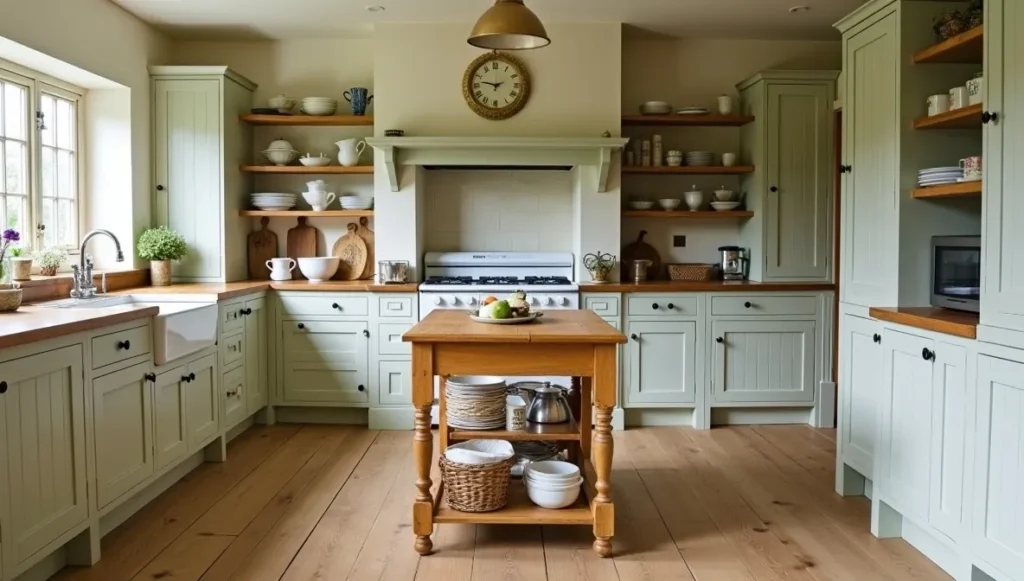
Bedrooms: Romantic Retreats
Bedrooms need to feel like retreats, not hotel rooms. Start with a bed that has some presence. Four-poster oak, painted iron, something with character. Then pile on the comfort: good cotton sheets, a wool throw, maybe an old quilt your grandmother would approve of.
Stick a reading chair by the window if you’ve got space. Not because it looks good in photos, but because there’s nothing better than settling in with a book while rain patters outside.
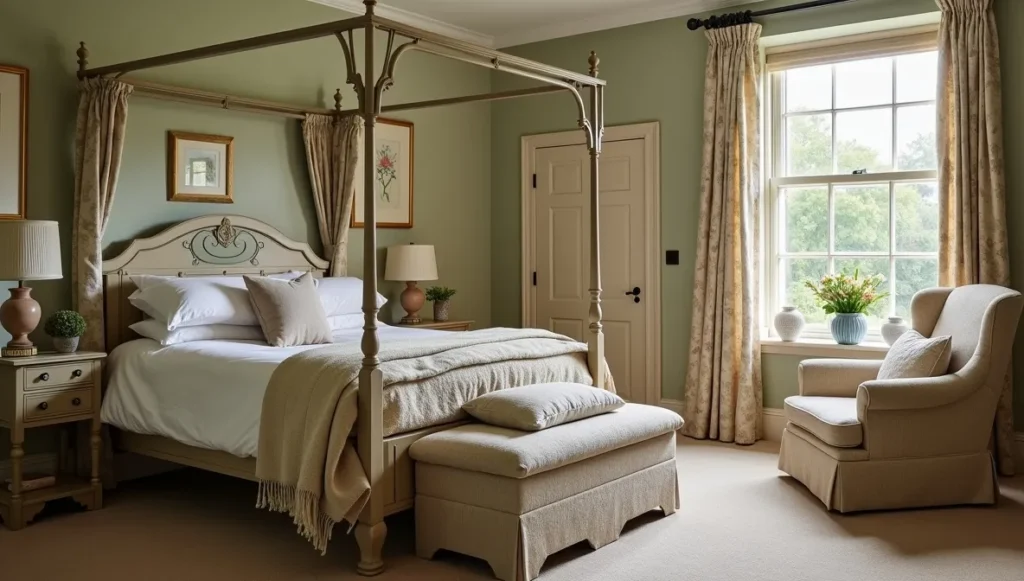
Children’s Rooms: Growing with Grace
Kids’ rooms in English Country style grow up gracefully. Skip the cartoon themes that’ll embarrass them in two years. Go with soft blues or greens that work whether they’re three or thirteen instead.
Buy furniture that’ll last. A proper wooden bed, a chest of drawers with good bones. Use fabrics for the fun stuff. Gingham curtains, a floral rug, some checked cushions. Easy to change when their tastes evolve.
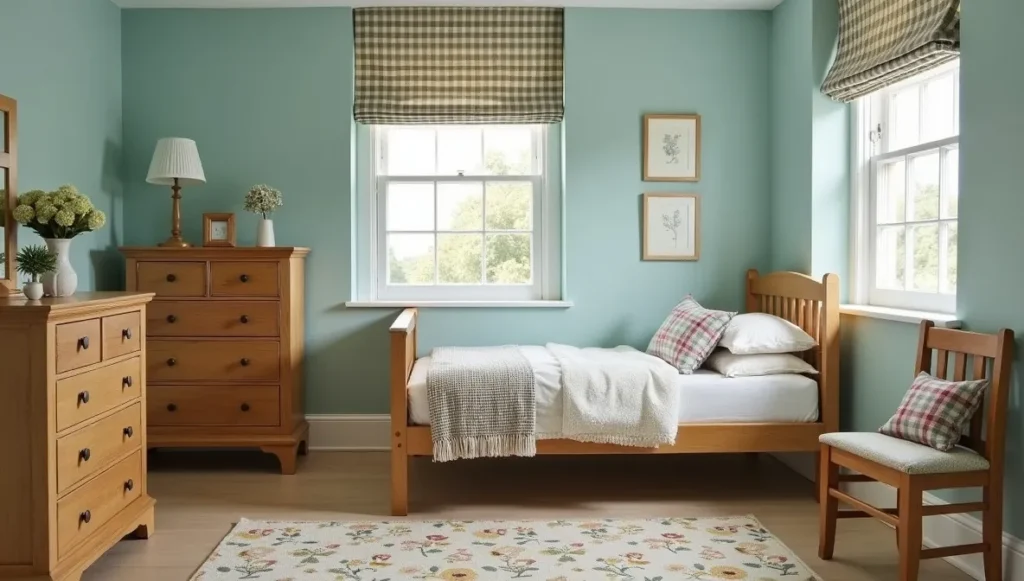
Bathrooms: Modern Comfort, Traditional Materials
Even bathrooms can get the English Country treatment without looking ridiculous. A clawfoot tub if you’ve got the space and budget. Some painted wood paneling halfway up the walls. Fixtures that aren’t trying to be sculptures.
The trick is making modern plumbing look like it belongs, not like it was bolted on as an afterthought.
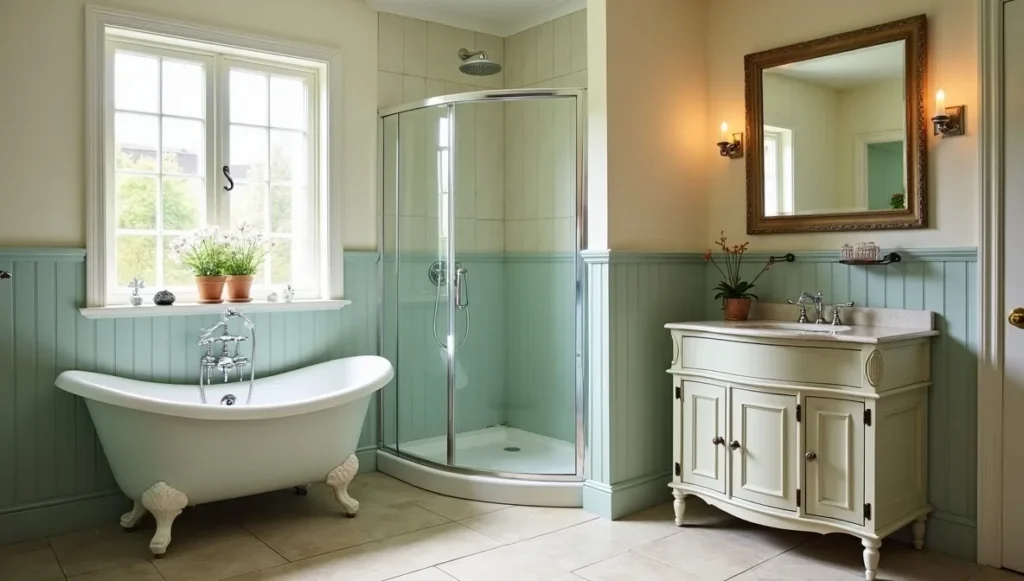
English Country vs. French Country: Key Differences
People mix these up constantly, and I get why. Both styles love natural materials and comfortable furniture. But here’s the thing, English Country keeps its colors quiet and sophisticated, while French Country isn’t afraid of that Provence sunshine yellow or lavender purple.
English furniture tends to be darker wood, often left natural or painted in deep colors. French pieces get painted in lighter shades and deliberately distressed, they have that chippy, weathered look that screams “I’ve been sitting in a barn for decades.”
The patterns tell the story too. English mixing feels more controlled, like someone with good taste made careful choices. French Country throws caution to the wind with bold toiles and bright florals that somehow work together through sheer exuberance.
Modern Applications and Sustainability
English Country isn’t about creating museum displays but rather lived-in spaces that feel personal. The style works beautifully in contemporary settings, urban apartments, and suburban homes through careful adaptation of principles rather than literal copying.
The emphasis on quality over quantity, repair over replacement, and inherited pieces naturally aligns with sustainable living. When clients invest in solid wood furniture and natural fiber textiles, they’re choosing pieces designed to last generations.
Creating Your Own English Country Haven
Start with textiles, they’re the quickest way to introduce warmth and pattern mixing. Invest in one significant piece that speaks to you, whether an antique armoire, Persian rug, or collection of transferware. Let this piece guide your other choices.
Remember that English Country style evolved over centuries through personal choices within individual means. Your version should reflect your life, collections, and needs. The goal isn’t perfection, it’s creating a home that welcomes you with open arms.
Why It Endures
English Country design endures because it never chased trends. This style developed organically from how people actually lived, prioritizing comfort and beauty equally. In our digital world, there’s profound appeal in interiors celebrating handcraft, natural materials, and objects with stories.
After all these years creating English Country interiors, I’m continually amazed by their ability to adapt and endure. Each project teaches me something new about balancing tradition with personal expression, proving that the best design styles aren’t rigid formulas but living philosophies that grow richer with time.
